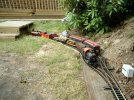Portsladepete
Registered
Seems like a similar story, I only went for the said wire because of the distance I thought I needed to cover from my furthest point/isolated siding. That siding has now evolved into the line to my second reverse loop, so now not essential to be isolated. The wire seems to be ok as long as it’s not regularly moved, I have two pieces that plug into my controller from my switch box, these are sprung connectors ,and are disconnected at the end of every session.I used some 40 year old 18 awg speaker wire for one set of sensor leads on my reverse loop module. The zip-cord wire insulation was clear and the multi-strand conductors were differentiated by one being tinned copper and the other bare. I had no trouble soldering a lug onto the tinned conductor. Trying to solder a lug to the bare conductor was a whole different animal! The bare conductor was obviously well oxidized. It was dark brown instead of a bright copper color. I ended up cutting the wire back almost a foot to get to wire that could be soldered. Even then it took alot more heat and flux than the tinned conductor.
I have had pretty good results using an AMTECH paste flux NC-559-ASM for electrical/electronic applications. I've tried a liquid rosin flux from GC electronics but the AMTECH paste works much better for me.
The weather down here seems set for a long wet winter again, so the running sessions are likely to be few and far between. Luckily my 00 layout is immune from the ravages of Cornish weather.
Think I am one of the “increased interest in garden railways” people caused by the lock down and the glorious month of sunshine in May. However I will persevere


